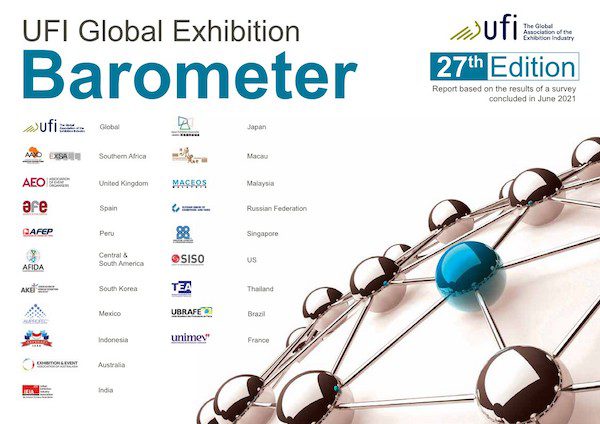UFI, the Global Association of the Exhibition Industry, has released the latest edition of its flagship Global Barometer research, which takes the pulse of the industry.
While the results highlight the strong impact the COVID-19 pandemic has had on the global exhibition industry in 2020, the situation is gradually improving, and there is a strong belief that the sector, primarily driven by physical exhibitions and business events, will bounce back quickly.
In terms of operations, the proportion of companies globally expecting “no activity” for the last quarter of 2021 has fallen from 53%, in January, to less than 10%, while the proportion of companies with “normal activity” has increased from 12% to close to 50%.
These results vary depending on region, and are primarily driven by the currently confirmed or expected “reopening dates” for exhibitions.
While several markets reportedly reopened in June 2021, the majority of companies in all regions expect both local and national exhibitions to open again in the coming 12 months, and international exhibitions to reopen in the first half of 2022.
When asked what element would most help toward the “bounce-back” of exhibitions, the majority of companies rank “lifting of current travel restrictions” (71% of answers), “readiness of exhibiting companies and visitors to participate again” (58% of answers), and “lifting of current public policies that apply locally to exhibitions” (55% of answers) as the key drivers.
Overall:
- 48% of companies have benefitted from some level of public financial support; for the majority of these, this represented less than 10% of their overall 2019 costs.
- 57% of companies have had to reduce their workforce; over half of these have made reductions of more than 25%.
- 10% of companies state they will have to permanently close if there is no business for the next six months.
In line with results from the last Barometer six months ago, “impact of the COVID-19 pandemic on the business” and “state of the economy in home market” are considered to be the two most important business issues, selected by 29% and 19% of respondents. “Global economic developments” (15% of respondents) “impact of digitization” (10% of respondents) and “internal management challenges” (9% of respondents) also remain high on the list of key business issues.
The digitization of products and services gained momentum throughout the pandemic, and 58% of respondents said they have added digital services/products (such as apps, digital advertising and digital signage) to their existing exhibition offerings. In addition, 40% have developed a digital transformation strategy for individual exhibitions or products.
In terms of future exhibition formats, global results indicate that 78% (up from 64% six months ago, and 57% 12 months ago) of respondents are confident that “COVID-19 confirms the value of face-to-face events,” anticipating that the sector will bounce back quickly.
 “The Barometer results confirm the severe impact of the pandemic on our industry. But as most markets have reopened, or know when they most likely will reopen, the bounce-back is on its way, and the sector is confident that COVID-19 will have reinforced the value of physical events, while also pushing the development of new digital products and services,” says Kai Hattendorf (pictured left), UFI Managing Director and CEO.
“The Barometer results confirm the severe impact of the pandemic on our industry. But as most markets have reopened, or know when they most likely will reopen, the bounce-back is on its way, and the sector is confident that COVID-19 will have reinforced the value of physical events, while also pushing the development of new digital products and services,” says Kai Hattendorf (pictured left), UFI Managing Director and CEO.
This latest edition of UFI’s bi-annual industry survey was concluded in June 2021, and includes data from a record number of 474 companies in 64 countries and regions.
The study also includes outlooks and analysis for 23 countries and regions–Australia, Brazil, Chile, China, Colombia, France, Germany, Hong Kong, India, Italy, Japan, Malaysia, Mexico, Russia, Singapore, South Africa, South Korea, Spain, Thailand, Turkey, the UAE, the UK and the US–as well as an additional five aggregated regional zones.
Regional results indicate that the Middle East & Africa and Central & South America regions are likely to be more affected than others, with a monthly average throughout 2021 of respectively 40% and 34% of “no activity” (31% in Europe, 25% in North America and 23% in Asia & Pacific) and only 22% and 20% of “normal activity” (27% in Asia & Pacific, 30% in Europe and 35% in North America).
Most regions agree that “lifting of current travel restrictions,” “readiness of exhibiting companies and visitors to participate again” and “lifting of current public policies that apply locally to exhibitions” are considered to be the “top three” elements that would most help toward the “bounce-back” of exhibitions, except the Middle East & Africa, where “mid-term visibility in terms of public policies, including travel restrictions” ranks third. North America and Central & South America rank “readiness of exhibiting companies and visitors to participate again” as the most important of these three elements.
Turnover–operating profits
Regional results indicate that:
- The revenue drop anticipated for 2021 is highest in the Middle East & Africa and Central & South America (respectively only 35% and 37% of 2019 revenues), followed by Europe (48%), Asia & Pacific (50%) and North America (55%).
- In terms of profits, the percentage of companies who have seen a loss for 2020 is 41% for North America, 44% for Asia & Pacific, 51% for the Middle East & Africa, 55% in Europe, and 59% for Central & South America.
Public financial support–workforce and perspectives
Regional results indicate that:
- The number of companies receiving public financial support is higher in Europe (65%) and Asia & Pacific (49%) than in North America (36%), the Middle East & Africa (18%) and Central & South America (8%).
- There was a higher reduction in workforce amongst companies in Central & South America (79%), the Middle East & Africa (73%) and North America (63%), than in Asia & Pacific (52%) and Europe (43%).
- The proportion of companies believing they will need to permanently close if business doesn’t resume within the next six months varies from 5% in North America and Europe, to 10% in Central & South America, 12% in the Middle East & Africa and 16% in Asia & Pacific.
Key business issues
Compared to global results, “impact of COVID-19 pandemic on the business” ranks higher in the Middle East & Africa (34%), “state of the economy in home market” ranks higher in Central & South America (26%), and “global economic developments” ranks higher in the Middle East & Africa (20%).
Further insight by type of activity highlights that while “impact of COVID-19 pandemic on the business” remains the main issue for all respondents, “internal management challenges” and “competition from within the industry” are the second and third main issues for service providers (respectively 18% and 16% of respondents). Meanwhile, “internal management challenges” ranks third for venues (18%) and organizers (16%).
Digitization
Fifty-eight percent of survey participants globally reported that they have added digital services and products (such as apps, digital advertising and digital signage) to their existing exhibition offerings, and this is especially the case in Asia & Pacific (67%).
In addition, while 40% of respondents globally indicated that they have developed a digital transformation strategy for individual exhibitions and products, this number was higher in North America, at 57%.
And while 37% of respondents globally stated that they have digitized internal processes and workflows, this number was again higher in North America, at 54%.
Future exhibition formats – physical and digital events
The results show no significant differences across regions as to possible trends regarding the format of exhibitions in the coming years.
Similarly, there are no strong regional differences with regard to the current and projected levels of activities related to hybrid or digital events in relation to physical events, although digital events have a stronger relevance in Central & South America, where 31% of events organized in 2021 will be digital, and 53% of companies believe that digital events will represent more than 10% of their income for the next two years.
Background
The 27th Global Barometer survey, conducted in June 2021, provides insights from 474 companies, covering 64 countries and regions. It was conducted in collaboration with 20 UFI member associations:
AAXO (The Association of African Exhibition Organisers) and EXSA (Exhibition and Event Association of Southern Africa) in South Africa, AEO (Association of Event Organisers) in the UK, AFE (Spanish Trade Fairs Association) in Spain, AFEP (Asociación de Ferias del Perú) in Peru, AFIDA (Asociación Internacional de Ferias de América) representing Central and South America, AKEI (Association of Korean Exhibition Industry) in South Korea, AMPROFEC (Asociación Mexicana de Profesionales en Ferias, Exposiciones, Congresos y Convenciones) in Mexico, EEAA (Exhibition & Event Association of Australasia) in Australia, IECA (Indonesia Exhibition Companies Association) in Indonesia, IEIA (Indian Exhibition Industry Association) in India, JEXA (Japan Exhibition Association) in Japan, MACEOS (Malaysian Association of Convention and Exhibition Organisers and Suppliers), in Malaysia, MFTA (Macau Fair & Trade Association) in Macau, RUEF (Russian Union of Exhibitions and Fairs) in Russia, SECB (Singapore Exhibition & Convention Bureau) in Singapore, SISO (Society of Independent Show Organizers) in the US, TEA (Thai Exhibition Association) in Thailand, UBRAFE (União Brasileira dos Promotores Feiras) in Brazil and UNIMEV (French Meeting Industry Council) in France.
In line with UFI’s objective to provide vital data and best practices to the entire exhibition industry, the full results can be downloaded at www.ufi.org/research
The next UFI Global Barometer survey will be conducted in December 2021.
UFI is the global association for the exhibition industry—tradeshow organizers and exhibition center operators, as well as the major national and international exhibition associations, and selected partners of the exhibition industry. Founded in 1925 as a non-profit, non-partisan, international association, UFI’s main goal is to represent, promote and support the business interests of its members and the exhibition industry. UFI directly represents more than 50,000 exhibition industry employees globally, and also works closely with its 60 national and regional association members. More than 800 member organizations in almost 90 countries around the world are presently signed up as members. Around 1,000 international trade fairs proudly bear the UFI approved label, a quality guarantee for visitors and exhibitors alike. UFI members continue to provide the international business community with a unique marketing media aimed at developing outstanding face-to-face business opportunities. UFI operates from four regional offices, in addition to its headquarters in Paris. For more info, visit www.ufi.org or call +33 (0)1 46 39 75 00.
































